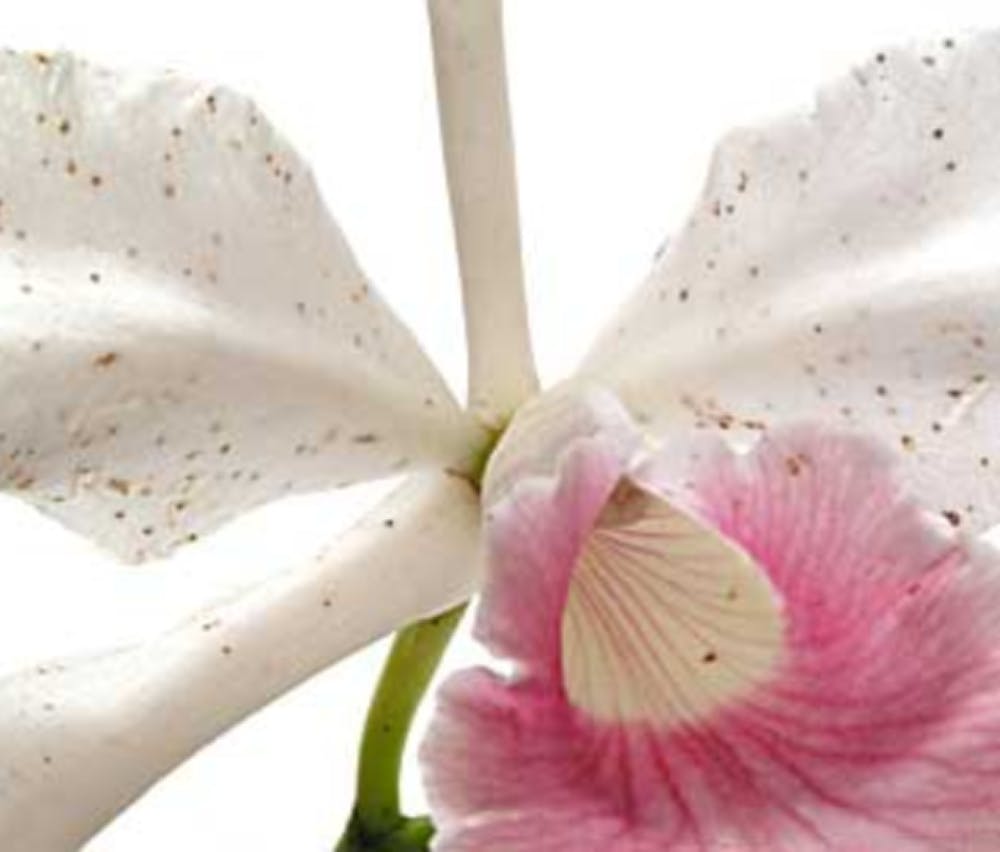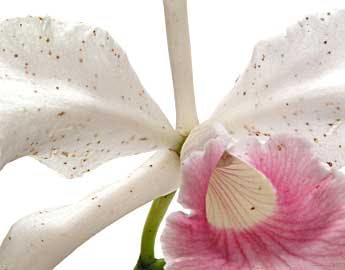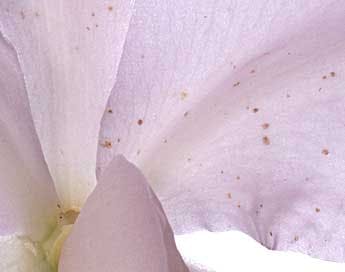
Botrytis


Gallery


Symptoms
Botrytis manifests as small, brown, black or gray necrotic spots on orchid flowers. Those spots may increase in size and number as the infection progresses, and may be surrounded by a pale pink margin. In severe infections, the spots can coalesce, and gray, webbed fungal growth (mycelium) may become visible.
Treatment
Once the botrytis spotting occurs, there is no treating it. Remove and dispose of all affected flowers to help prevent the spread of the fungus. Remove infected flowers, then spray with a suitable fungicide labeled for Botrytis such as Daconil. Some report success with the home remedy of baking soda, 1/2 tsp dissolved in 1 quart of water sprayed on the flowers. Always follow label instructions. This fungus is common in the environment and cannot be eradicated.
Prevention
The best form of control for botrytis is prevention, which involves sanitation, air circulation and careful watering.
Sanitation. Inspect the growing area for conditions favorable to botrytis. As this pathogen thrives and winters over on dead and dying plant material, remove any plant debris, spent or fallen flowers and leaves from the growing area to reduce the possibility of spreading the fungus.
Air Movement. Keep plenty of fresh air moving through the growing area and around plants at all times. A stagnant, damp environment with inadequate air circulation promotes the growth of botrytis. Good air circulation is a necessity to prevent fungal infections year round, but most especially when plants are in bloom. Increasing the ambient temperature and air movement and decreasing the humidity during cool, damp weather will help eliminate any excess moisture on plant tissue, thus minimizing the chances of infection.
Temperature. Keep nighttime temperatures above 65 F.
Watering. When watering, avoid wetting the plant and its flowers, if possible. Water that remains on petals or leaves after a rain or watering encourages fungal growth. Watering early in the day helps ensure that the plant and its flowers will be dry by nightfall. Never allow blooms or foliage to remain wet overnight.
Further Reading
Fortner, Linda. September, 1998. Caring For Orchids Part Two: Air Movement and Quality. Suite 101.com: The Orchid Garden Web site.
Orchid Growing — Pests and Diseases: Petal Blight. Web site.
Schuster, James, Extension Educator, Horticulture, and reviewed by Bruce Palsrud, Extension Specialist, Pesticide Applicator Training, Department of Crop Sciences, University of Illinois at Urbana- Champaign. Grey Mold (Botrytis). Web site.
Simone, Gary W., PhD, and Harry C. Burnett, PhD. Diseases Caused by Bacteria and Fungi: Flower Blights In Orchid Pests and Diseases. Florida: American Orchid Society, 1995, pp. 69–70.
2003. Orchids (Orchidaceae) Plant Pest Problems — Diseases Caused by Fungi: Petal blight, Botrytis cinerea. Plant Pest Handbook, Connecticut Agricultural Experiment Station Web site.
Life Cycle
The fungus winters primarily on dead and dying plant material, and begins producing and dispersing spores during cool, damp weather in the spring or autumn. Damp conditions, rapidly rising humidity or disturbing infected plants may release spores into the surrounding growing area. Spores can be distributed by wind, rain or any mechanical action. Temperatures in the mid 60's to low 70's F (18–23 C), and wet plant surfaces or ambient humidity of at least 92 percent, are ideal conditions. The fungus can proliferate very quickly, infecting healthy plant tissue in as little as 14 hours.
Sanitation
Inspect the growing area for conditions favorable to botrytis. As this pathogen thrives and winters over on dead and dying plant material, remove any plant debris, spent or fallen flowers and leaves from the growing area to reduce the possibility of spreading the fungus. Some growers recommend removing and disposing of all affected flowers to help prevent the spread of the fungus, and even burning or burying of affected plant tissue.
Circulation
Keep plenty of fresh air moving through the growing area and around plants at all times. A stagnant, damp environment with inadequate air circulation promotes the growth of botrytis. Good air circulation is a necessity to prevent fungal infections year round, but most especially when plants are in bloom. Increasing the ambient temperature and air movement and decreasing the humidity during cool, damp weather will help eliminate any excess moisture on plant tissue, thus minimizing the chances of infection. In most areas, orchids grown outdoors already have the necessary air movement in their environment.
Watering
When watering, avoid wetting the plant and its flowers, if possible. Water that remains on petals or leaves after a rain or watering encourages fungal growth. Watering early in the day helps ensure that the plant and its flowers will be dry by nightfall. Never allow blooms or foliage to remain wet overnight.
Companion plants may host a variety of pests and diseases that also affect orchids, including botrytis. Inspect any companion plants in the growing area for signs of the fungus. Some plants susceptible to botrytis include African violets, amaryllis, Amazon lily, azaleas, begonias, cacti, caladium, calla lily, camellias, castor beans, chrysanthemums, cinerarias, coleus, cornflowers, dahlias, dracaenas, dusty millers, ferns, fig, fuchsias, gardenias, gloxinias, heliotrope, passion flower and poinsettias.
Finally, isolate any new plants for a minimum of two weeks before admitting them to your growing area and into your orchid collection. During the isolation period, keep a close eye on the new acquisition for signs of any pest or disease that could be spread to other plants.
Control
Once the botrytis spotting occurs, there is no removing it — only preventing future occurrences. A fungicide such as thiphanate methyl, iprodione, vinclozolin or Physan can be applied as needed to prevent further outbreaks. Since the infection primarily affects flower petals, many growers do not recommend the use of fungicides. As with any chemical, always use it in strict compliance with the manufacturer’s instructions.

FREE ACCESS: Orchid DealWire
Get notified when orchid vendors have special promotions and exclusive savings.







